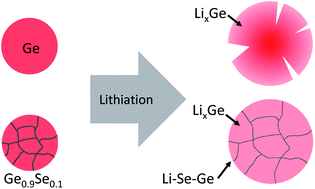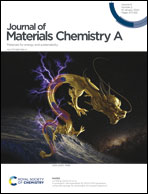In situ and operando investigation of the dynamic morphological and phase changes of a selenium-doped germanium electrode during (de)lithiation processes†
Abstract
To understand the effect of selenium doping on the good cycling performance and rate capability of a Ge0.9Se0.1 electrode, the dynamic morphological and phase changes of the Ge0.9Se0.1 electrode were investigated by synchrotron-based operando transmission X-ray microscopy (TXM) imaging, X-ray diffraction (XRD), and X-ray absorption spectroscopy (XAS). The TXM results show that the Ge0.9Se0.1 particle retains its original shape after a large volume change induced by (de)lithiation and undergoes a more sudden morphological and optical density change than pure Ge. The difference between Ge0.9Se0.1 and Ge is attributed to a super-ionically conductive Li–Se–Ge network formed inside Ge0.9Se0.1 particles, which contributes to fast Li-ion pathways into the particle and nano-structuring of Ge as well as buffering the volume change of Ge. The XRD and XAS results confirm the formation of a Li–Se–Ge network and reveal that the Li–Se–Ge phase forms during the early stages of lithiation and is an inactive phase. The Li–Se–Ge network also can suppress the formation of the crystalline Li15Ge4 phase. These in situ and operando results reveal the effect of the in situ formed, super-ionically conductive, and inactive network on the cycling performance of Li-ion batteries and shed light on the design of high capacity electrode materials.



 Please wait while we load your content...
Please wait while we load your content...